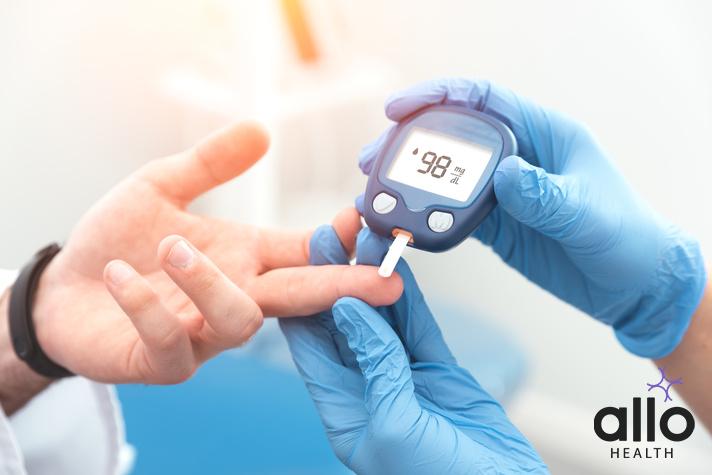PPBS Test During Pregnancy

Allo Health is dedicated to personalized well-being, offering support and trusted information tailored to individual health goals. The platform emphasizes human-generated content, led by a distinguished medical team of experts, including physicians and sexual health specialists. Their commitment to credibility involves rigorous fact-checking, authoritative research, and continuous updates to ensure accurate, up-to-date information. Allo Health's unique approach goes beyond conventional platforms, providing expert-led insights and a continuous commitment to excellence, with user feedback playing a crucial role in shaping the platform's authoritative voice.

Dr. Aditi completed her undergraduate medical education at AJIMS, Mangalore, after which she worked in multi-speciality hospitals with COVID patients and in the Pain and Palliative medicine department. Driven by her experiences, she developed a keen interest in psychiatry. Dr. Aditi believes that mental health is just as, if not more important, than physical health.
Why This Was Upated?
Our experts continually monitor the health and wellness space, and we update our articles when new information became available.
Updated on 06 January, 2024
- Article was updated as part of our commitment to diversity, equity, and inclusion.

"The following blog article provides general information and insights on various topics. However, it is important to note that the information presented is not intended as professional advice in any specific field or area. The content of this blog is for general educational and informational purposes only.
Book consultation
The content should not be interpreted as endorsement, recommendation, or guarantee of any product, service, or information mentioned. Readers are solely responsible for the decisions and actions they take based on the information provided in this blog. It is essential to exercise individual judgment, critical thinking, and personal responsibility when applying or implementing any information or suggestions discussed in the blog."
If you’re pregnant, you’ve likely already been told about the variety of tests you’ll undergo throughout your pregnancy. One such test is the PPBS test, also known as the postprandial blood sugar test. This test is essential as it measures your blood sugar levels after a meal, providing your healthcare provider with important information about how your body is processing sugar during pregnancy.
What Is PPBS Test?
PPBS stands for “Postprandial Blood Sugar,” and it refers to a type of blood glucose (sugar) test that measures the level of sugar in your blood after a meal. This test is also known as a post-meal blood sugar test or a postprandial glucose test. It is commonly used to monitor and manage diabetes, a condition in which the body has difficulty regulating blood sugar levels.
Here’s a detailed overview of the PPBS test:
Purpose
The PPBS test is used to assess how well your body is able to manage blood sugar levels after you’ve consumed a meal. It helps healthcare professionals determine how efficiently your body processes glucose and how quickly your blood sugar levels rise and then return to normal after eating.
Procedure
- Preparation: You’ll be asked to fast for a certain period of time before the test. This is usually about 8 to 10 hours overnight, similar to what’s recommended before a fasting blood sugar test. Fasting helps establish a baseline blood sugar level before eating.
- Consuming a Meal: After the fasting period, you’ll be given a standardized meal or instructed to eat a specific meal that contains a known amount of carbohydrates. Carbohydrates are the main nutrient that significantly affects blood sugar levels.
- Blood Sampling: A blood sample is taken through a small needle inserted into a vein, usually from your arm. The first blood sample is collected just before you start eating the meal. Subsequent blood samples are taken at specific intervals after eating, usually at 1 hour and 2 hours post-meal.
Interpretation
The results of the PPBS test are used to evaluate how your body responds to the intake of carbohydrates and how effectively it regulates blood sugar. In a person without diabetes, blood sugar levels rise after eating but generally return to normal levels within a couple of hours. In individuals with diabetes, blood sugar levels might remain elevated for longer periods.
Importance
The PPBS test is valuable for individuals with diabetes because it provides insights into how their diet choices, medications, and lifestyle changes are affecting their blood sugar levels. This information helps doctors and individuals make adjustments to their treatment plans to achieve better blood sugar control and reduce the risk of diabetes-related complications.
Remember that medical interpretation and advice should be sought from a healthcare professional, as they can provide personalized recommendations based on your specific health condition and needs.
Why Is PPBS Test During Pregnancy Important?
The Postprandial Blood Sugar (PPBS) test during pregnancy, also known as postprandial glucose test, is a crucial component of prenatal care, especially for women who have been diagnosed with gestational diabetes mellitus (GDM) or are at risk of developing it. Gestational diabetes is a form of diabetes that develops during pregnancy and affects how your body handles glucose (sugar). The PPBS test plays a significant role in monitoring and managing blood sugar levels in pregnant women for several reasons:
- Detection of Gestational Diabetes: Gestational diabetes is a common condition that can develop during pregnancy due to hormonal changes that affect insulin resistance. It’s important to diagnose and manage gestational diabetes because uncontrolled high blood sugar levels can pose risks to both the mother and the developing fetus.
- Assessing Blood Sugar Control: The PPBS test helps healthcare providers assess how well a pregnant woman’s body is able to manage blood sugar levels after consuming meals. High blood sugar levels after eating can indicate insulin resistance or impaired glucose tolerance, which are key indicators of gestational diabetes.
- Risk Management: Gestational diabetes can lead to complications for both the mother and the baby. For the mother, it increases the risk of high blood pressure (preeclampsia), cesarean delivery, and type 2 diabetes later in life. For the baby, it can lead to excessive birth weight (macrosomia), which increases the risk of birth injuries and the need for cesarean delivery. It can also lead to low blood sugar levels in the newborn (neonatal hypoglycemia) and an increased risk of developing obesity and type 2 diabetes later in life.
- Treatment Adjustment: The PPBS test results help healthcare providers tailor treatment plans for pregnant women with gestational diabetes. This can involve dietary modifications, exercise recommendations, and sometimes insulin therapy to ensure that blood sugar levels are maintained within a safe range.
- Preventing Complications: By effectively managing blood sugar levels through the PPBS test, the risk of complications associated with gestational diabetes can be reduced. This includes reducing the likelihood of birth complications and improving the long-term health outcomes for both the mother and the baby.
- Monitoring Progress: Regular PPBS tests provide ongoing feedback on how dietary changes, lifestyle modifications, and any prescribed medications are impacting blood sugar levels. This allows healthcare providers to make necessary adjustments to the treatment plan as the pregnancy progresses.
- Preventing Type 2 Diabetes: Women who have had gestational diabetes are at an increased risk of developing type 2 diabetes later in life. Monitoring blood sugar levels during pregnancy can serve as an opportunity to identify those at risk and provide guidance for lifestyle changes that can reduce the risk of developing type 2 diabetes in the future.
What Is PPBS Normal Range?
The normal range for postprandial blood sugar (PPBS) levels can vary, but generally, they are as follows:
- 1 hour after a meal: Less than 180 mg/dL (10 mmol/L)
- 2 hours after a meal: Less than 140 mg/dL (7.8 mmol/L)
These values might differ based on individual circumstances and guidelines provided by healthcare professionals. Additionally, different sources and organizations may have slightly varying ranges. Always consult with your healthcare provider to understand the specific target ranges that apply to your situation.
Frequently Asked Questions
(1) Why is the PPBS test important during pregnancy?
The PPBS test is crucial because it helps identify gestational diabetes, a condition that can lead to complications for both the mother and the baby. Uncontrolled high blood sugar levels can cause concerns like preeclampsia, cesarean delivery, excessive birth weight, and neonatal hypoglycemia. By monitoring blood sugar levels, healthcare providers can create effective treatment plans to keep blood sugar within a safe range, reducing risks and ensuring a healthier pregnancy.
(2) How is the PPBS test performed?
The PPBS test involves fasting for a specific period and then consuming a meal with a known amount of carbohydrates. Blood samples are taken before and after the meal, usually at 1 and 2 hours after eating. These samples help healthcare providers assess how your body processes glucose after meals and whether there’s a need for interventions to manage blood sugar levels.
(3) What are the risks of not taking the PPBS test seriously during pregnancy?
If gestational diabetes goes unmanaged, it can lead to complications like high blood pressure, cesarean delivery, and type 2 diabetes for the mother. Babies born to mothers with uncontrolled gestational diabetes might have birth injuries, low blood sugar, and an increased risk of obesity and diabetes later in life. Taking the PPBS test seriously and following recommended treatments reduces these risks.
(4) Can the PPBS test help prevent diabetes after pregnancy?
Yes, the PPBS test can play a role in preventing type 2 diabetes after pregnancy. Women who’ve had gestational diabetes are at higher risk for developing type 2 diabetes later. By monitoring blood sugar levels during pregnancy, healthcare providers can identify those at risk and offer guidance for lifestyle changes that lower the chances of developing type 2 diabetes in the future. Regular monitoring and healthy choices can make a positive impact on long-term health.
(5) What should I do if I have high PPBS test results during pregnancy?
If your PPBS test shows high blood sugar levels, follow your healthcare provider’s guidance. They might recommend dietary changes, increased physical activity, or, in some cases, insulin therapy to manage your blood sugar levels. Regularly monitoring your blood sugar and adhering to the treatment plan can help prevent complications for you and your baby.
(6) How often will I need to take the PPBS test during pregnancy?
The frequency of PPBS tests can vary based on individual circumstances and healthcare provider recommendations. Typically, women diagnosed with gestational diabetes might need to take the test multiple times a week to ensure their blood sugar levels are under control. Regular testing helps healthcare providers make adjustments to treatment plans as needed.
(7) Can I prevent gestational diabetes by making lifestyle changes?
While some risk factors for gestational diabetes are beyond your control, making healthy lifestyle changes can help reduce the risk. Maintaining a balanced diet, staying physically active, and managing your weight before and during pregnancy can lower the likelihood of developing gestational diabetes. some factors, like genetics and hormonal changes, can still influence your risk.
(8) How does gestational diabetes affect my baby’s health?
Gestational diabetes can impact your baby’s health by causing excessive growth, leading to complications during delivery. Additionally, high blood sugar levels can affect the baby’s blood sugar after birth, potentially causing neonatal hypoglycemia. Babies born to mothers with gestational diabetes might also have a higher risk of obesity and type 2 diabetes later in life.
(9) Will gestational diabetes go away after pregnancy?
For many women, gestational diabetes resolves after giving birth. Continue monitoring your blood sugar levels after pregnancy and follow up with your healthcare provider. Some women might develop type 2 diabetes later in life, so maintaining a healthy lifestyle and regular check-ups are crucial for long-term health.






































